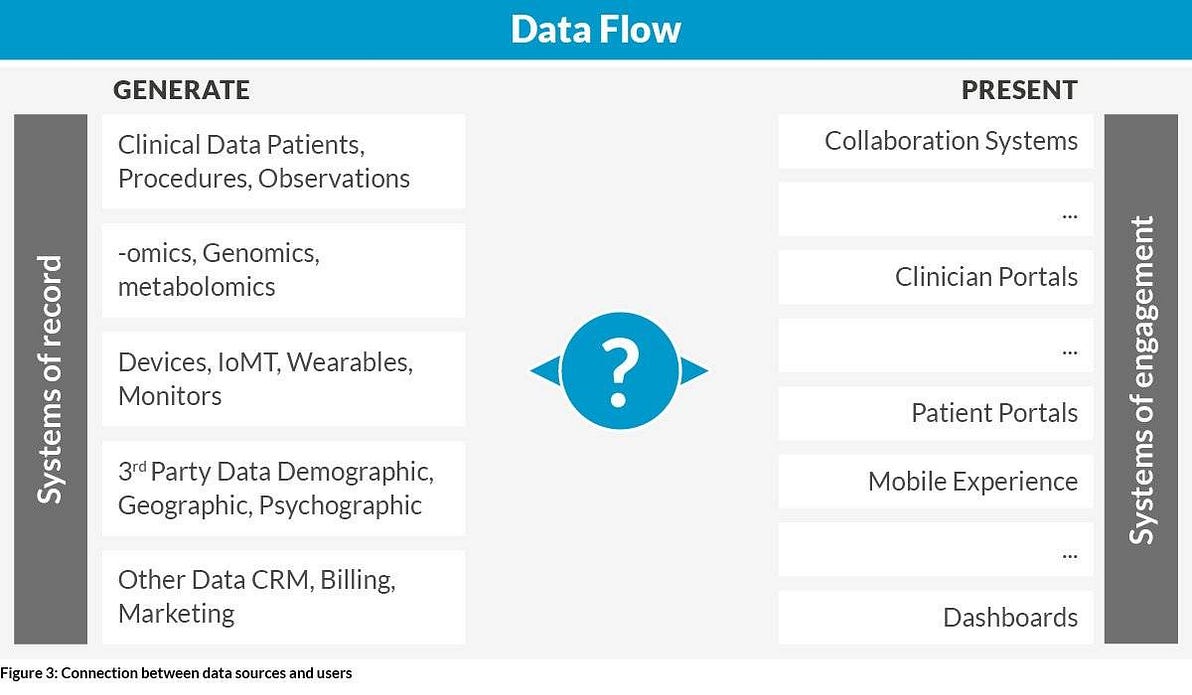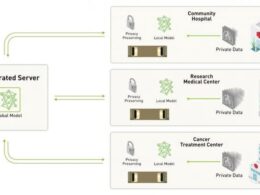Zuhlke
Blazej Jacholkowski
February 3, 2022
Key messages
- The rapidly increasing volumes of health data are both a blessing and a curse for medtech and pharmaceutical companies
- Digital Health Platforms are a key technology when it comes to making this data usable and manageable
- This article describes how companies can approach this topic — and gain valuable advantages
Digital health platforms (DHPs) promise to help life sciences companies develop innovative digital healthcare solutions. But what exactly do DHPs do — and do you need one?
Pharmaceutical, medical device and healthtech companies, as well as organizations in the healthcare sector (such as hospitals and clinics), are creating and collecting more and more data.
But there’s a problem: figuring out how to use that data to actually improve patients’ health.
But there’s a problem: figuring out how to use that data to actually improve patients’ health.
For example, in 2018, hospitals worldwide performed 3.6 billion imaging procedures and produced an average 50 petabytes of data each (90% of which was imaging data).
But 97% of it went unused or unanalyzed.
in 2018, hospitals worldwide performed 3.6 billion imaging procedures and produced an average 50 petabytes of data each (90% of which was imaging data).
But 97% of it went unused or unanalyzed.
There’s no doubt that there would be huge value in finding out what insights might be hidden in this data.
For example, AI technologies would be very well suited to helping radiologists identify patterns in imaging.
Knowledge is power. But data, in itself, is just numbers on a page. You also need a way to get value from it.
And right now, most healthcare data is stuck in silos and legacy systems, with all of its potential value locked away.
Knowledge is power. But data, in itself, is just numbers on a page. You also need a way to get value from it.
And right now, most healthcare data is stuck in silos and legacy systems, with all of its potential value locked away.
That’s where digital health platforms come in.
Some enable you to store, manage and use all the data you hold, or can access.
That provides a strong foundation for the development of medical-grade applications (like medical apps and ‘digiceuticals’) as well as the formation of new ecosystems with healthcare institutions and the myriad of innovative startups.
Structure of the publication
- Types of platforms
- Bridging the gap between data and engagement
- Bringing order to messy data
- Key requirements
- Make or buy?
- Platforms as a Service (PaaS)
- How it works in practice

Types of platforms
Before we go on, a quick word of clarification is needed.
The word ‘platform’ is currently used by companies in a variety of different contexts, and there are many types of digital platforms in the health space.
Below are the main categories of platforms we have identified:
- Research platforms to aggregate specific types of health data for R&D purposes (Flatiron, DNAnexus, IBM Watson Health…)
- Telehealth platforms to connect healthcare service providers with patients and provide virtual care services (Amwell, Grandrounds, Teladoc…)
- Software development platforms used to develop software-as-medical-device (SaMD) solutions (Voluntis Theraxium, Smartpatient, S3 Connected Health Affinial…)
- Clinical Data Management platforms used to manage clinical trials (Oracle ClinicalOne, Medidata, IQVIA…)
- CRM systems for customer relations management (SalesForce…)
- Horizontal regulated technology platforms to manage health data from any source and build applications, available as a Platform as a Service or PaaS (Siemens Healthineers, Phillips HealthSuite, Brightinsight…).
In this post, we focus on the last of these, which have been specifically engineered and certified for the health industry in order to allow IT teams to develop any type of medical application while fully complying with all laws and regulations of the healthcare sector.
Horizontal regulated technology platforms — to manage health data from any source and build applications, available as a Platform as a Service or PaaS (Siemens Healthineers, Phillips HealthSuite, Brightinsight…).
We will refer to these platforms as ‘DHPs’.

Bridging the gap between data and engagement
Leveraging data and software as a medical device (SaMD) represents a huge opportunity to improve patient care, diagnosis and treatments.
They allow life sciences organizations to offer patient-centric solutions that extend across the full patient journey.
Digitalization will make healthcare far more efficient and could finally make the vision of ‘precision healthcare’ a reality.
However, none of that can happen unless data can be efficiently stored, analyzed and shared.
A DHP can help bridge the gap between systems of record, where data is generated and stored (e.g. device, clinical and third-party data), and systems of engagement, such as clinician and patient portals, apps and collaboration systems.
A DHP can help bridge the gap between systems of record, where data is generated and stored (e.g. device, clinical and third-party data), and systems of engagement, such as clinician and patient portals, apps and collaboration systems.

Bringing order to messy data
Patient data is complex, making it hard to bridge the gap between data generation and systems of engagement.
Patient data may originate from multiple sources, and is often stored across several different IT systems (each with its own unique formatting).
Because this data reflects medical interactions with the patient, the same data points may not be available for every patient, and careful consideration must be given to potential patterns of bias before interpreting the results.
This creates a special challenge when trying to connect providers to share data about patients or clinical studies.
The more various and numerous people want to use data, the more complicated and expensive it becomes to access it.
It’s a similar story in the medical Internet of Things (‘IoMT’), where software developers, device manufacturers and cloud providers are all converging on a new market and trying to lay claim to the same data.
Many data governance policies have been drafted by lawyers, who take a very conservative stance in order to assure compliance with data protection laws.
While caution is certainly justified, this can come at the cost of progress, as data gets tied up in red tape and can’t be used to its full potential to help patients.
A good DHP can offer the compatibility needed to combine multiple data streams, enabling companies to recognize the full value of data without compromising on privacy, security or quality.
Of course, a successful digital product still isn’t guaranteed. But a DHP does provide a firm foundation to build on.
A good DHP can offer the compatibility needed to combine multiple data streams, enabling companies to recognize the full value of data without compromising on privacy, security or quality.

Key requirements
Life sciences organizations have very specific platform requirements, making it even more important to choose the right one.
One vital area is regulatory compliance.
For example, when you develop a new medicine, you must submit a Design History File (DHF) to authorities.
This details how the product was developed and how it achieves regulatory compliance.
Without the necessary IT infrastructure, creating a DHF is very complex and time-consuming, notably because of all of the necessary documentation that must be generated.
But with the right DHP in place, it’s far easier.
Another key concern is development capability.
For example, some platforms, such as BrightInsight, offer pre-built templates for software as a medical device (SaMD) to speed up development, with support for regulatory changes.
This allows organizations to focus on the functionality of the product, rather than the nuts and bolts of developing it.
some platforms… offer pre-built templates for software as a medical device (SaMD) to speed up development, with support for regulatory changes.
This allows organizations to focus on the functionality of the product, rather than the nuts and bolts of developing it.

Make or buy?
One solution is to build a DHP from scratch.
But life sciences companies aren’t tech companies; their core competence is in developing medicines, not apps and digital platforms.
Make no mistake: developing a DHP is a major project that will demand a great deal of money, expertise and time.
According to BrightInsight, it can cost up to $20M to build a backend infrastructure and around $10M per year to maintain it.
… it can cost up to $20M to build a backend infrastructure and around $10M per year to maintain it.
At the other end of the scale, organizations could tap into an ‘off the shelf’ regulated health platform, which we look into in the section below.
Then there is also an intermediary solution: to reach out to Cloud providers, who in recent years have developed offerings in healthcare and life sciences, and have components compliant with most regulations.
As these cloud providers aren’t domain experts, it makes sense to work together with an integration partner who can provide the domain expertise, as well as the customization and integration needed to adapt the solution.
On top of that, many healthcare providers are concerned about patient privacy and data protection in the public cloud, with the potential for the GDPR to be circumvented.
That has led them to adopt hybrid systems (a combination of cloud and on-premise infrastructure).

Platforms as a Service (PaaS)
The make-or-buy dilemma provided an opportunity for medtech providers like Phillips and Siemens Healthineers, who understand both healthcare data and providers.
They have developed platforms that are tailored to the needs of life science organizations, and fully compliant with regulations too.
These DHPs are available on a ‘Platform as a Service’ (PaaS) basis.
In this model, the vendor provides the platform itself and the infrastructure to run it, while the customer (a life sciences company) provides the data and develops the applications that make use of it.
The PaaS model allows companies to tap into a scalable subscription-based service without the hassle of building and maintaining their own infrastructure or setting up ‘first-mile’ connectivity to sources of patient data.
The developer has already worked through the challenges that building a DHP entails, so the customers of the PaaS don’t have to.
With PaaS, organizations can access, develop and run applications using a single platform. That reduces the time, effort and resources needed to drive digital transformation and improves their time to market.
With PaaS, organizations can access, develop and run applications using a single platform. That reduces the time, effort and resources needed to drive digital transformation and improves their time to market.
Certification and regulatory compliance are built in, as are security and privacy. Users can also take advantage of curated ‘building blocks’ designed especially for life-science companies, which will speed development still further.
However, there is no ‘one-size-fits-all’, and there are significant differences between the various platforms on the market (notably, on the software architecture level).
So having the support of a neutral, independent expert engineering consultancy can help to make the right choice, with substantial implications for the business.
However, there is no ‘one-size-fits-all’, and there are significant differences between the various platforms on the market (notably, on the software architecture level).
So having the support of a neutral, independent expert engineering consultancy can help to make the right choice, with substantial implications for the business.

How it works in practice
Ypsomed is a medical device manufacturer that commercializes devices and solutions directly and also builds custom-made products for pharmaceutical and medical-device companies.
A few years ago, Ypsomed developed a ‘smart’ insulin injector device, along with a self-injection device. While conducting clinical trials, they needed to build a complete cloud-based backend infrastructure in order to interconnect the patient, the clinicians and the manufacturer.
Ypsomed decided to partner with Philips, who provided them with a turnkey digital solution for remote adherence monitoring and connected device management through their HealthSuite platform.
By using HealthSuite, Ypsomed could achieve an MVP of a private cloud solution, Ypsocloud, in less than six months, realizing major savings in terms of implementation time and costs.
Ypsocloud paired patients’ smartphones with the connected devices and their prescribed use, monitored relevant clinical and technical data and verified patient compliance (dosage times and amounts). Ypsomed could then manage the insulin injector remotely, and offer users an app that showed them how to use the device along with a dashboard for the physician to track patients’ insulin injections, hence supporting the clinical decision-making process.
Originally published at https://www.zuehlke.com on February 3, 2022.












